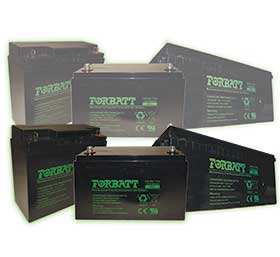

Sealed lead acid (SLA) batteries are the technology of choice for numerous applications as a source of backup power, emergency power supply and to serve as part of a power storage system.
Not all batteries are created equal, and just as you would choose a suitable tyre for your car, it is important to choose a correct and suitable battery for your equipment or device. It is obvious to imagine the implications of fitting a truck with 14-inch tyres or a small car with a caterpillar track; although the implications of using an inappropriate battery may not be so immediately obvious, doing so will inevitably increase costs and maintenance expense, and result in unsatisfactory performance and a shortened battery life.
For example, in an application such as equipment which demands high bursts of current at startup, it would not be suitable to use a general-purpose SLA battery. Although both batteries might have a similar basic design and look the same, using the battery not designed for this startup application would result in deterioration of the battery plates, reduced battery capacity and premature failure.
Moreover, because of the different terminal design, the terminal of a general-purpose SLA battery has less cross-sectional area which would cause a risk of the terminals melting when starting an engine that requires high current. It is also possible for a spark to be caused that might result in the battery exploding, due to the different terminal fastening types.
One size does not fit all
As an example, let us compare the ideal battery needed for the power supply of a portable, handheld device with that needed for a telecoms application. Frankly, there is no electrical or electronic reason why the same battery could not be used for both applications, but in general portable devices will favour a small battery for easy carrying rather than a big battery that provides longer periods of operating time.
The batteries used in telecom, communications or electrical equipment need to be durable and stable, but it is also important to consider the power consumption required to choose a suitable battery with enough capacity to supply sufficient backup power in the event of a power cut. Even then, batteries of the same size may well have different capacities. It is important to explain to the battery supplier what your application requirements are, or check the equipment instructions to select the most suitable battery.
Other key considerations when selecting the correct battery are the specific type of application and what its power requirements are, such as whether it is used for emergency power supply, startup, backup power, energy storage or other functions.
As an emergency power supply, the power consumption needs to be considered so that a suitable battery is chosen to offer sufficient power during a power outage. If the location is subjected to frequent power interruptions, it is recommended to choose a battery with a capacity more than 25% of the required consumption to prevent over-discharging.
For a cranking battery for equipment startup, such as a jump starter, it is better to pick a battery designed to deliver a high burst of amps. This kind of battery is different from the design for backup power supply in that it has thicker but fewer battery plates and uses a different alloy formula. There is always a trade-off, and the downside is that this kind of battery might not excel in terms of lifecycle performance over the long run.
When it comes to applications in energy storage and backup power, Forbatt Gel batteries are recommended due to their VRLA (valve regulated lead acid) and AGM (absorbed glass mat) design which have the advantages of being maintenance-free and featuring low resistance, low discharge rates and long life which can significantly reduce maintenance costs.
As mentioned above, these batteries have some differences in the battery plates, grid pasting material and electrolyte that gives them different performance advantages in different applications. It cannot be emphasised enough how vital it is to choose the correct battery for the equipment or application to get the best performance and achieve maximum efficiency.
What to look for
When deciding what battery is best, confirm the requirements of the application or follow the instructions for the equipment. Although a battery with higher capacity comes at a higher cost, that should be a secondary consideration behind making sure the battery provides sufficient performance and preventing it from being damaged.
Also pay attention to selecting a correct charging method. Compared to other kinds of battery, the VRLA battery is very sensitive to charging. Faulty procedures or inadequate charging methods that over-discharge and over-charge will result in failure to recover normal capacity, reduced capacity, or shortened battery service life.
Always choose a reputable supplier to avoid inferior products. Forbatt has more than 30 years’ experience in the battery industry, and its batteries are rated among the best on the market for a number of reasons. Forbatt batteries are manufactured with the highest quality cells and components to guarantee excellent and stable performance.

© Technews Publishing (Pty) Ltd | All Rights Reserved